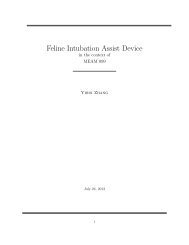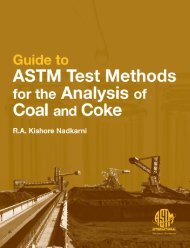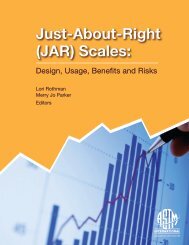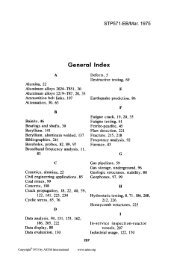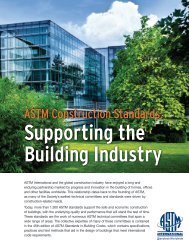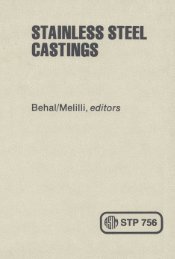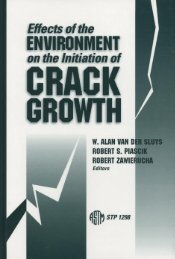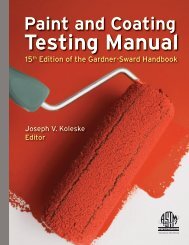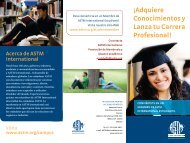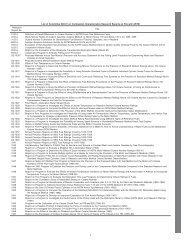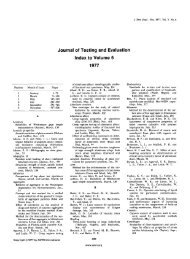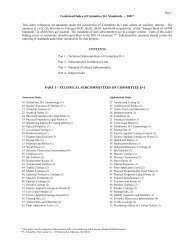Semiconductor Processing - ASTM International
Semiconductor Processing - ASTM International
Semiconductor Processing - ASTM International
You also want an ePaper? Increase the reach of your titles
YUMPU automatically turns print PDFs into web optimized ePapers that Google loves.
SEMICONDUCTOR<br />
PROCESSING<br />
#<br />
A symposium<br />
sponsored by <strong>ASTM</strong><br />
Committee F-1 on Electronics,<br />
National Bureau of Standards,<br />
<strong>Semiconductor</strong> Equipment and Materials Institute,<br />
and Stanford University IC Laboratory<br />
San Jose, CA, 7-10 Feb. 1984<br />
<strong>ASTM</strong> SPECIAL TECHNICAL PUBLICATION 850<br />
D. C. Gupta, Siliconix Inc., editor<br />
<strong>ASTM</strong> Publication Code Number (PCN)<br />
04-850000-46<br />
1916 Race Street, Philadelphia, PA 19103
Library of Congress Cataloging in Publication Data<br />
<strong>Semiconductor</strong> processing.<br />
(<strong>ASTM</strong> special technical publications; 850)<br />
"<strong>ASTM</strong> publication code number (PCN) 04-850000-46."<br />
Includes bibliographies and index.<br />
1. <strong>Semiconductor</strong> industry—Congresses. I. Gupta,<br />
D. C. (Dinesh C.) II. <strong>ASTM</strong> Committee F-1 on Electronics.<br />
III. Series: <strong>ASTM</strong> special technical publication; 850.<br />
TK7871.85.S467 1984 621.3815'2 84-18476<br />
ISBN 0-8031-0403-0<br />
Copyright © by AMERICAN SOCIETY FOR TESTING AND MATERIALS 1984<br />
Library of Congress Catalog Card Number: 84-18476<br />
NOTE<br />
The Society is not responsible, as a body,<br />
for the statements and opinions<br />
advanced in this publication.<br />
Printed in Baltimore, MD<br />
October 1984
Foreword<br />
The Third Symposium on <strong>Semiconductor</strong> <strong>Processing</strong> was<br />
held at San Jose, California on 7-10 February, 1984<br />
under the chairmanship of Dinesh C. Gupta, Siliconix<br />
Incorporated. It was sponsored by <strong>ASTM</strong> Committee F-1<br />
on Electronics and co-sponsored by the National Bureau<br />
of Standards, <strong>Semiconductor</strong> Equipment and Materials<br />
Institute and Stanford University Integrated Circuits<br />
Laboratory. The Technical Committee was headed by<br />
Edward E. Gardner, IBM Corporation and the<br />
Arrangements and Publicity Committee by Carl A.<br />
Germane, Motorola Incorporated.<br />
The following persons participated in the Advisory<br />
Board, and various Committees, namely; the Technical<br />
Committee, the Arrangements and Publicity Committee,<br />
Registration Committee and the Spouse Committee: Lisa<br />
Anderson, SEMI; Kenneth E. Benson, AT&T Bell<br />
Laboratories; W.Murray Bullis, Siltec Corporation;<br />
Kathleen Bullis; Michael H. Christ, Dynamit Nobel<br />
Silicon; Peter Douglas, American Fine Wire<br />
Corporation; Terry A. Francis, Air Products<br />
Corporation; Barbara Germano; Gilbert A. Gruber,<br />
Siliconix, Inc., Lou Ann Gruber; Vijay Gupta; Heinz<br />
Herzer, Wacker-Chemitronic, Philip L. Lively, <strong>ASTM</strong>;<br />
Robert D. Larrabee, National Bureau of Standards;<br />
Robert E. Lorenzini, Siltec Corporation; Samuel L.<br />
Marshall, Solid State Technology; Jan Meighan, San<br />
Jose Convention Bureau; James D. Meindl, Stanford<br />
University; Eric Mendel, IBM Corpoation; J. Timothy<br />
Raab, Rockwell <strong>International</strong>; Robert I. Scace,<br />
National Bureau of Standards; Donald G. Schimmel, AT&T<br />
Bell Laboratories; Fritz G. Vieweg-Gutberlet, Wacker-<br />
Chemitronic and William R. Wheeler, Tencor<br />
Instruments.<br />
In addition, the guidance was provided by the Chairmen<br />
and the officers of <strong>ASTM</strong> Committee F-1 on Electronics<br />
and its various subcommittees. The following persons<br />
presided the technical and workshop sessions:<br />
K.G.Barraclough, Royal Signals & Radar Establishment;<br />
K.E.Benson, AT&T Bell Laboratories; W.M.Bullis, Siltec<br />
Corporation; P.L.Castro, Hewlett-Packard Laboratories;<br />
M.I.Current, Trilogy Systems Corporation; P. Douglas,<br />
American Fine Wire Corporation; C. A. Germano,<br />
Motorola, Inc., G.G.Harman, National Bureau of<br />
Standards; H. Herzer, Wacker-Chemitronic; P. H.<br />
Langer, AT&T Bell Laboratories; R. D. Larrabee,<br />
National Bureau of Standards; B. J. Masters, IBM<br />
Corporation; J.H.Matlock, SEH America Inc., A. R.<br />
Neureuther, University of California, Berkeley; A.<br />
Rapa, IBM Corporation; W. R. Schevey, Allied Chemical
Corporation; G.R.Srinivasan, IBM Corporation; B.Stone,<br />
Monsanto Company & C.J.Varker, Motorola Incorporated.<br />
We are specially indebted to William Cavanaugh,<br />
President of <strong>ASTM</strong>, for an impressive talk on "The<br />
Role of <strong>ASTM</strong> in the Electronics Industry", Sheldon<br />
Weinig, Chairman, Materials Research Corporation and a<br />
member of the President's Advisory Council on Private<br />
Sector Initiatives who presented a dinner speech on<br />
"Competitive IC Market: Will Automation and Technology<br />
Improvements Offset the Rising Costs of Manufacturing<br />
and Equipment", and to the members of the panel on<br />
Cooperative Research; Erich Bloch, Chairman,<br />
<strong>Semiconductor</strong> Research Cooperative and Director,<br />
National Science Foundation; Richard Fair, Vice<br />
President, Microelectronics Center of North Carolina;<br />
Angel Jordan, Provost, Carnegie-Mellon University;<br />
James Meindl, Director, Stanford Center for Integrated<br />
Systems; and William Oldham, Professor, University of<br />
California, Berkeley. The panel was moderated by Dr.<br />
Angel G. Jordan.<br />
We are grateful to the members and the guests of <strong>ASTM</strong><br />
Committee F-1 and SEMI who were called upon from time<br />
to time for special assignments during the two-year<br />
planning of the Symposium.<br />
Over one hundred and forty persons participated in the<br />
review process for the papers published in these<br />
proceedings. Without their participation, this<br />
publication would not have been possible. And finally,<br />
we acknowledge the hard work and efforts of the staff<br />
of publication, review and editorial departments of<br />
<strong>ASTM</strong> in bringing out this book.
A Note of Appreciation<br />
to Reviewers<br />
The quality of the papers that appear in this pubHcation reflects not only<br />
the obvious efforts of the authors but also the unheralded, though essential,<br />
work of the reviewers. On behalf of <strong>ASTM</strong> we acknowledge with appreciation<br />
their dedication to high professional standards and their sacrifice of time and<br />
effort.<br />
<strong>ASTM</strong> Committee on Publications
Related<br />
<strong>ASTM</strong> Publications<br />
Silicon <strong>Processing</strong>, STP 804 (1983), 04-804000-46<br />
Lifetime Factors in Silicon, STP 712 (1980), 04-712000-46<br />
Laser-Induced Damage in Optical Materials: 1982, STP 847 (1984),<br />
04-847000-46<br />
Laser-Induced Damage in Optical Materials: 1981, STP 799 (1983),<br />
04-799000-46
Preface<br />
The papers in this volume were presented at the Third<br />
Symposium on <strong>Semiconductor</strong> <strong>Processing</strong> held in San<br />
Jose, California on 7-10 February 1984. The symposium<br />
was sponsored by <strong>ASTM</strong> Committee F-1 on Electronics,<br />
and co-sonsored by National Bureau of Standards,<br />
<strong>Semiconductor</strong> Equipment & Materials Institute and<br />
Stanford University Integrated Circuits Laboratory. In<br />
addition to the technical presentations, the symposium<br />
included well-attended workshops and panel<br />
discussions; impressions of these workshops and panel<br />
discussions are provided in appendices I-III.<br />
The symposium addressed new problems in semiconductor<br />
technology for the mid 80's which arise from the rapid<br />
increases in device complexity and performance,<br />
emergence of integrated systems on-a-chip,<br />
automated factories, and silicon foundries. The<br />
realization of acceptable yields and reliability in<br />
the face of these demands requires greater<br />
manufacturing discipline from starting materials to<br />
finished devices. The symposium theme was chosen to be<br />
Quality Through Measurement and Control.<br />
The symposium opened with the talks on the role of<br />
<strong>ASTM</strong> in the electronics industry by William T.<br />
Cavanaugh, <strong>ASTM</strong>, and the impact of standards on<br />
semiconductor quality and manufacturing efficiency by<br />
W. Murray Bullis, Siltec Corporation. These<br />
presentations were followed by two keynote papers, one<br />
on the process and device modeling for VLSI structures<br />
by James D.Plummer, Stanford University and the other<br />
on the equipment requirements for the VLSI production<br />
by Wilmer R. Bottoms, Varian Associates. Both these<br />
papers described techniques and equipments needed to<br />
achieve the required functional yields in complex<br />
devices on an integrated circuit chip.<br />
The opening general session included a discussion on<br />
the Cooperative Research among industry, academia and<br />
government. Brief summaries of activities at the<br />
<strong>Semiconductor</strong> Research Cooperative, Microelectronics<br />
Center of North Carolina, Stanford Center for<br />
Integrated Systems and the University of California at<br />
Berkeley were presented. A synopsis of the panel<br />
discussion in response to key questions from the<br />
audience is presented in appendix I.<br />
Many other forums including the Fifth <strong>International</strong><br />
Conference on Neutron Transmutation Doping and the
CHMT chapter of IEEE decided to meet with the<br />
Symposium.<br />
The response to the symposium was extremely favorable<br />
once again. The involvement of industry, academia and<br />
government including the participation of foreign<br />
institutions confirmed a continued need for a regular<br />
forum to discuss technology topics in the context of<br />
measurement and control; a consistent theme which the<br />
Symposium established in 1982 evolving the<br />
understanding and control of the complex process<br />
technologies required for VLSI and other advanced<br />
device concepts.<br />
The plans for the next symposium in 1986 in the series<br />
of symposia to be held at two-year intervals are<br />
underway. The problem areas and standardization needs<br />
identified in these symposia will provide the feedback<br />
to the research community and voluntary standards<br />
system essential for the future growth of the<br />
industry.<br />
The cooperation and support of the <strong>ASTM</strong> staff in the<br />
formulation of these proceedings is appreciated.<br />
Finally, we are indebted to our industrial, government<br />
and university colleagues who contributed to the<br />
contents of the Symposium and the Proceedings.<br />
San Jose, California. Dinesh C. Gupta
Contents<br />
Introduction<br />
STANDARDS IN SEMICONDUCTOR INDUSTRY<br />
The Impact of Standards on <strong>Semiconductor</strong> Quality and<br />
Manufacturing Efficiency—w. MURRAY BULLIS 9<br />
FABRICATION TECHNOLOGY<br />
Process and Device Modeling for VLSI Structures—<br />
JAMES D. PLUMMER 21<br />
Effect of Process Conditions on Autodoping in Silicon Epitaxy—<br />
HSUEH-RONG CHANG 38<br />
An Intrinsic Gettering Process to Improve Minority Carrier Lifetimes<br />
in MOS and Bipolar Silicon Epitaxial Technology—<br />
JOHN O. BORLAND, MAX KUO, JAMES SHIBLEY,<br />
BRUCE ROBERTS, ROLAND SCHINDLER, AND TERRY DALRYMPLE 49<br />
Control of Gain Variations in Shallow Junction Ion Implanted<br />
Bipolar Transistors Caused by Planar Channelling—<br />
DAVID J. BAZLEY 63<br />
Ion Implantation for Deep [ > 100 ^m] Buried Layers—<br />
WOLFGANG R. FAHRNER, DIETER BRAUNIG, MEINHARD KNOLL,<br />
AND JOACHIM R. LASCHINSKI 77<br />
A Study of Strain in Ion Implanted Silicon—MASAYOSHI SASAKI AND<br />
KOUICHI SAKAMOTO 96<br />
Dry Etching Using NFj/Ar and NFs/He Plasmas—JOHN BARKANIC,<br />
ANDREW HOFF, JOSEPH STACH, AND BOGDAN GOLJA 110<br />
Edge-Controlled, Self-Consistent Proximity Effect Corrections—<br />
HARRY L. BERKOWITZ, CHARLES F. COOK, JR.,<br />
JOSEPH H. KWIATKOWSKI, AND WAYNE M. GOODREAU 124
The Effect of Wafer Flatness on Yield by Off-line Computer<br />
Simulation of the Photolithographic Process—LOUIS DENES 143<br />
CONTROL OF PARTICULATE CONTAMINATION<br />
Forms of Contamination Affecting Device <strong>Processing</strong>—<br />
ANGELO C. RAPA 163<br />
Problems Associated with Submicrometre Contaminant<br />
Measurement—ALVIN LIEBERMAN 172<br />
Point-of-Use Ultrafiltration of Deionized Rinse Water and Effects on<br />
Microelectronics Device Quality—PETER W. GAUDET 184<br />
DEFECTS AND GETTERING TECHNIQUES<br />
The Effects of Wafer Thermal History on the 450°C Thermal Donor<br />
Formation in Cz-Grown P(IOO) Silicon—<br />
JOHN OGAWA BORLAND 201<br />
Interaction Between Point Defects and Oxygen in Silicon—<br />
JOSEPH R. MONKOWSKI, DANIEL HECK, THOMAS A. BAGINKSI,<br />
DAVID KENNEY, AND RICHARD E. TRESSLER 219<br />
Effects of Oxygen on Process-Induced Defects and Gettering in<br />
Cz-Silicon—ROBERT B. SWAROOP 230<br />
Precipitation Behavior of Deposited Metals in Cz-Silicon—<br />
HISAAKI SUGA, YASUSHI SHIMANUKI, KOJI MURAI, AND<br />
KAZUYOSHI ENDO 241<br />
Evaluation of Gettering Efficiency of Backside Damage by the Use of<br />
the "Haze" Test—MARCELLO DOMENICI,<br />
GIANCARLO FERRERO, AND PAOLO MALINVERNI 257<br />
Extrinsic Gettering Via the Controlled Introduction of Misfit<br />
Dislocations—ALI S. M. SALIH, HYEONG J. KIM,<br />
ROBERT F. DAVIS, AND GEORGE A. ROZGONYI 272<br />
The Effect of Si-SiOj Interface on the Excess Point Defect<br />
Distribution in Silicon—YUN-SEUNG SHIN AND CHOONG-KI KIM 283
MATERIAL AND PROCESS CHARACTERIZATION<br />
Fracture Tracing in <strong>Semiconductor</strong> Wafers—LAWRENCE D. DYER 297<br />
A Preferential Etch for Silicon Crystals—K. H. YANG 309<br />
Oxygen Determination in Silicon Using Fourier Transform Infrared<br />
Spectroscopy—L. W. SHIVE AND B. K. SCHULTE 320<br />
A Study of the Spatial Distribution of the Oxygen Content in Silicon<br />
Wafers Using an Infrared Transmission Microscope—<br />
KRISHNASWAMY KRISHNAN AND DONALD KUEHL 325<br />
Influence of Electrically Active Impurities on IR Measurements of<br />
Interstitial Oxygen in Silicon—s. p. WEEKS 335<br />
The Effects of Instrumental Artifacts on the Quantitative<br />
Determination of Oxygen in Silicon by FTIR—<br />
ASLAN BAGHDADI 343<br />
Simultaneous Determination of the Boron and Phosphorus Content in<br />
Silicate Glasses by FTIR Spectroscopy—<br />
KRISHNASWAMY KRISHNAN 358<br />
A Method to Determine the Initial Phosphorus and Boron<br />
Concentrations in Float-Zoned Polysilicon Rods—<br />
HERNG-DER CHIOU 364<br />
The Effects of RF Electromagnetic Radiation on Spreading<br />
Resistance Measurements—ROBERT G. MAZUR 375<br />
Dopant Profiling in Silicon—MAREK PAWLIK 390<br />
Comparison of Depth Profiling of '"B in Silicon Using Spreading<br />
Resistance Profiling, Secondary Ion Mass Spectrometry, and<br />
Neutron Depth Profiling—JAMES R. EHRSTEIN,<br />
R. GREGORY DOWNING, BRIAN R. STALLARD, DAVID S. SIMONS,<br />
AND RONALD F. FLEMING 409<br />
INTERCONNECTION TECHNOLOGY: WIRE AND TAPE BONDING<br />
The Ball Bond Shear Test: Its Methodology and Application—<br />
HARRY K. CHARLES, JR., GUY V. CLATTERBAUGH, AND<br />
JOEL A. WEINER 429
The Annealing and Low Temperature Aging Characteristics of Fine<br />
Diameter Wire Produced from Dilute Aluminum Alloys—<br />
DAVID F. HEBERT 458<br />
Capacitive Microphone Tuning of Ultrasonic/Thermosonic<br />
Bonders—WILLIAM L. LOOFBOURROW 472<br />
A Comparative Study of the Mechanical Properties of Bonding<br />
Wire—s. P. HANNULA, I. WANAGEL, AND C. Y. LI 485<br />
New Applications of Tape Bonding for High Lead Count Devices—<br />
JAMES F. MARSHALL AND ROBERT P. SHEPPARD 500<br />
Bumped Tape <strong>Processing</strong> and Application—FRANK A. LINDBERG 512<br />
NEUTRON TRANSMUTATION DOPING TECHNIQUES AND FACILITIES<br />
Production and Development of Neutron Transmutation Doped<br />
Silicon—HEINZ HERZER 533<br />
Production of Detector-Grade Silicon by Neutron Transmutation<br />
Doping—WILFRIED VON AMMON AND J. KEMMER 546<br />
Neutron Transmutation Doping in Hydrogenated Amorphous<br />
Silicon—H. HAMANAKA, K. KURIYAMA, M. YAHAGI,<br />
K. IWAMURA, C. KIM, F. SHIRAISHI, K. TSUJI, AND<br />
S. MINOMURA 558<br />
Effects of Hydrogen on Defects in Neutron Irradiated Silicon—<br />
YONGCHANG DU, YUFENG ZHANG, AND XIANGTI MENG 566<br />
Neutron Transmutation Doping of Semi-Insulating Czochralski-<br />
Grown GaAs—ANDREW T. HUNTER, MARY H. YOUNG,<br />
HARVEY V. WINSTON, OGDEN J. MARSH, AND RON R. HART 575<br />
Ion Channeling Study of Damage in Neutron Transmutation Doped<br />
<strong>Semiconductor</strong>s: Application to GaAs—M. YAHAGI, M. SATOH,<br />
K. KURIYAMA, K. IWAMURA, C. KIM, AND F. SHIRAISHI 587<br />
A New Silicon Irradiation Facility in the PLUTO MTR at Harwell—<br />
J. BAXTER AND N. W. CRICK 595
Equalization of Axial Neutron Flux Density for the Transmutation<br />
Doping of Silicon in a Heavy Water Reactor—<br />
KIRSTEN ANDRESEN, KAJ HEYDORN, AND ERIK NONB0L 605<br />
Potential for Large-Diameter NTD Silicon Production in the<br />
Advanced Test Reactor—j. STEPHEN HERRING AND<br />
ROBERT E. KORENKE 615<br />
Advanced Test Reactor NTD Silicon Production Hardware—<br />
MARK J. SCHELL 628<br />
APPENDIXES<br />
Appendix I—Panel Discussions<br />
Cooperative Research Programs 647<br />
Appendix H—Workshop Sessions<br />
Control of Contaminants 654<br />
Interconnection Technology 655<br />
Appendix HI—Panel Discussions<br />
Material and Process Induced Defects 657<br />
Ion Implantation 660<br />
Advanced Lithographic Technology 662<br />
Index 665


